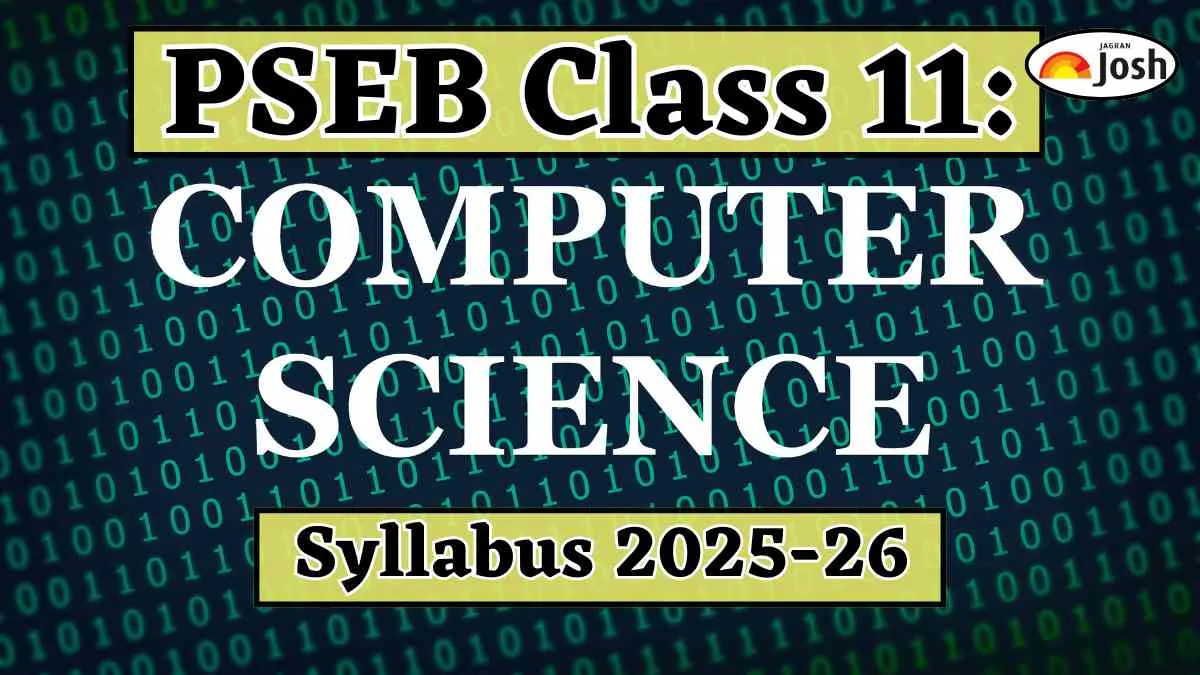The PSEB Class 11 Computer Science syllabus may be downloaded in PDF format here. The syllabus must be examined in order for students to become acquainted with the course material and exam format for the upcoming academic year 2025–2026.
The vast array of topics covered in the PSEB Class 11 Computer Science syllabus introduces students to the basics of computers and the internet. Students are intended to acquire fundamental information and abilities in the following areas with the aid of the syllabus: It teaches students HTML, the foundation of webpages, and assists them in exploring the stages of website construction. Its main focus is on computer security and maintenance procedures, such as preventive maintenance and common problem solving.
PSEB Class 11 Computer Science Syllabus: Learning Outcomes
Students should be able to:
a) Develop basic computational thinking using Python
b) Explain and use of data types, operators and control statements and other fundamental topics of Python
c) Ability to understand the issues related to Cyber-Crimes and Safety, EWaste Management
d) Introduction to IT Act
e) Ability to follow basic cyber ethics
f) Understanding of Various types of Number Systems used by Computer Systems
g) Ability to have understanding of various concepts of Databases
h) Ability to use and work with SQL statements
PSEB Class 11 Computer Science Syllabus: Key Highlights
| Board Name | Punjab School Education Board (PSEB) |
| Class | 11 |
| Subject | Computer Science |
PSEB Class 11 Computer Science: Detailed Syllabus 2025-26
Check the table below to know the full syllabus of Punjab Board Class 11 Computer Science:
Theoretical Section Unit I
| Number System: Number Systems: Introduction, Decimal Number System, Binary Number System, Octal Number System, Hexadecimal Number System |
| DBMS and SQL: -
Database concepts: Introduction to Data, Information, Database and its needs, Traditional File System v/s Database System -
Data Models: Introduction, Hierarchical Data Model, Network Data Model, Relational Data Model -
Introduction to DBMS: DBMS, Components of DBMS -
Relational Data Model: Relation, Attribute, Tuple, Domain, Degree, Cardinality, Keys (Candidate Key, Primary Key, Alternate Key, Foreign Key) -
SQL |
| Computer System Maintenance: -
Introduction: Computer Maintenance and Security -
Preventive Maintenance: Basic Guidelines for Preventive Maintenance Booting and Safe -
Mode Problems: How to Start Windows in Safe Mode, How to Fix Your PC in Safe Mode-Scan for Malware, Run System Restore, Uninstall Recently Installed Software, Update Hardware Drivers, To check system crashes -
Installation of Device Drivers: Download the drivers manually, How to install the driver; Plug and Play Hardware Installation -
Type of Ports: Serial Port, Parallel Port, PS/2 Port, Universal Serial Bus (or USB) Port, VGA Port, Power Connector, Modem Port. Ethernet Port. Digital Video Interface, DVI port -
PC Security Tools: Importance of PC Security tools Software Update and Upgrade -
Introduction to Windows Operating Systems: Windows 10, Windows 8.1, Windows 7 Installation of Python (GUI), IDEs -
Control Panel: Display Properties, Mouse and Keyboard, Date and Time, Devices and Printers, Regional Settings, Fonts -
Utility Programs: File Compression tools, Disk Defragmentation, Disk Clean-up, Backup and Restore -
Shutting Down Options: Switch User, Log Off, Lock Screen, Restart, Sleep, Hibernate, Shut Down or Turn Off |
Unit-II
| Python Programming: -
Basic concepts for Python Programming: Python Character Set, Python Tokens (Keyword, Identifier, Literal, Operator, Punctuator), Variables, Concept of L-Value and R-Value, Use of Comments -
Data Types: Number (Integer, Floating Point, Complex), Boolean, Sequence (String, List, Tuple), None, Mapping (Dictionary), Mutable and Immutable -
Data Types Operators: Arithmetic Operators, Relational Operators, Logical Operators, Assignment Operator, Augmented Assignment Operators, Identity Operators (is, is not), Membership Operators (in, not in) -
Introduction: Use of Indentation, Sequential Flow, Conditional and Iterative Flow control -
Expressions, Statement, Type Conversion & Input/Output: Precedence of Operators, Expression, Evaluation of Expression, Python Statement, Type Conversion (Explicit & Implicit Conversion), Accepting Data as Input from the Console and Displaying Output |
| Cyber Security and Ethics -
Cyber-Crime: Definition, Hacking, Spying (Eavesdropping), Phishing and Fraud Emails, Ransomware, Preventing Cyber Crime -
Cyber Safety: Safely Browsing the Web, Identity Protection, Confidentiality, Cyber Trolls and Bullying Safely Accessing -
Web Sites: Adware, Malware, Viruses, Trojans, Phishing and Identity Verification -
E-Waste Management: Proper disposal of used Electronic Gadgets -
IT Act: Indian Information Technology Act (IT Act) 2000 |
To Download PSEB Class 11 Computer Science Syllabus 2025-26, Click the link below
Also Check:
PSEB Class 11 Accountancy Syllabus 2025-26
PSEB Class 11 Biology Syllabus 2025-26
PSEB Class 11 Business Studies 2025-26
PSEB Class 11 Chemistry Syllabus 2025-26
